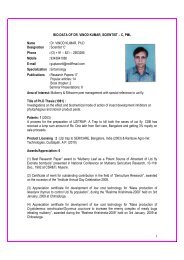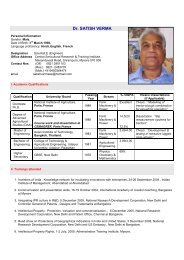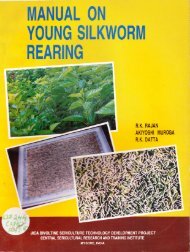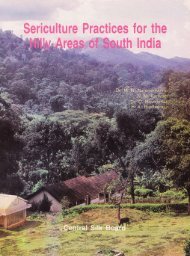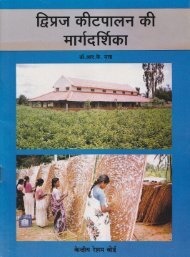Mulberry
Mulberry Cultivation in South India - Central Sericultural Research ...
Mulberry Cultivation in South India - Central Sericultural Research ...
Create successful ePaper yourself
Turn your PDF publications into a flip-book with our unique Google optimized e-Paper software.
Row.System<br />
Pit System<br />
5th Application<br />
6th Application<br />
60 kg. N as straight fertiliser r.e.6 bags of<br />
Ammonium sulphate or 23la bags of Urea.<br />
40 kg. N as straight fertiliser i.e. 4 bags of<br />
Ammonium sulphate or 13/o bags of Urea.<br />
40 kg. N as straight fertiliser l.e. 4 bags of<br />
Ammonium sulphate or i3/o bags of Urea.<br />
Total 300 kg. N +120 kg. P + 120 kg. K 280 kg. N + 120 kg. p + 120 kg. K<br />
Application of fertilisers should be carried out within three to four weeks {ollowing<br />
pruning operation in the case of row system. ln the case of pit system, however, the<br />
first application following the pruning is given within three to four weeks of pruning and<br />
thereafter, subsequent applications are given within two to thrqe weeks of every leaf<br />
harvest.<br />
The fertilisers should be applied with due care by spreading evenly on either sides<br />
of the plants along the row and completely incorporated into the soil 6y digging in or<br />
forking in for effective utilisation by the plants. Otherwise, they will run the risk of<br />
getting decomposed in hot sun or leached out in heavy rains.<br />
iv) lrrigation:<br />
Among various agronomic inputs to which mulberry plant responds very well,<br />
irrigation ranks high as it enables full utilisation of very heavy applications of fertiliser<br />
for crop production. Since this item of input is fairly expensive, judicious use of water<br />
for maximising production is very important.<br />
Under South lndian conditions, particularly in Karnataka, the sericultural tracts<br />
receive fairly distributed rains from May to November amounting to 25t30,, and all that<br />
needs to be done for helping the plant growth is to supplement the rains with the<br />
required irrigations which may be 5 to 6 in number. During the dry period from<br />
December to April, however, systematic irrigation should be given regularly at roughly<br />
about a week to ten days' interval, depending upon the soil condition and its water<br />
holding capacity. ln light sandy loam soils more frequent irrigation at a week's interval<br />
may be found necessary while in heavy clayey loam soils, irrigation at l0 to 14 days<br />
inierval may be found adequate.<br />
It is also important to remember that at the above intervals of irrigation, adequate<br />
quantities of water should be supplied as irrigation at a time. lt has been estimated that<br />
111, ta 2 acre inches of water is required per irrigation and therefore, this quantity<br />
should be supplied without fail. lt is being observed that sericulturists have a tendency<br />
to water their gai'dens lightly but too frequently, quite often at every three or four days<br />
14




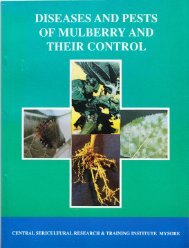

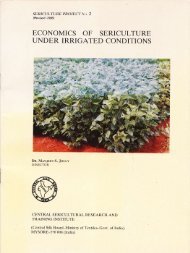
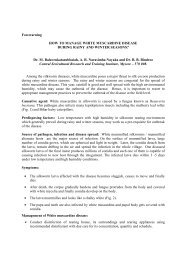
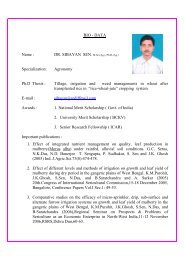
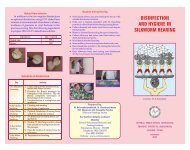
![E}A]\GALORE](https://img.yumpu.com/54052619/1/190x260/eagalore.jpg?quality=85)

